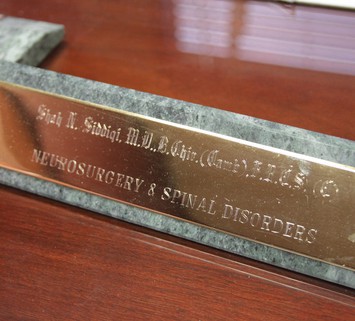An Anterior Cervical Discectomy and Fusion (ACDF) is a medical procedure that offers pain relief to individuals suffering from neck pain caused by cervical spine issues. Whether it's a herniated disc, degenerative disc disease, or spinal stenosis, ACDF can significantly improve quality of life by addressing these often debilitating conditions. However, Anterior Cervical Discectomy and Fusion recovery requires true adherence to post-surgical instructions.
In this blog, we will explore the ins and outs of an ACDF procedure, including who may require it and the benefits and complications associated with the procedure. We will also provide recovery tips and instructions. By understanding and following the recommended recovery path, patients can embark on their journey with confidence, knowing that a pain-free, functional life awaits on the other side.
What is an Anterior Cervical Discectomy and Fusion?
ACDF is a surgical procedure performed to address various cervical spine conditions, including the following:
Herniated Discs
When the soft inner core of a cervical disc in the neck bulges or ruptures, it can compress nearby nerves, leading to pain, numbness, and weakness in the arms.
Degenerative Disc Disease
Over time, the discs between the vertebrae can degenerate, causing pain and reducing mobility in the neck.
Spinal Stenosis
The narrowing of the spinal canal can put pressure on the spinal cord and nerves, resulting in pain and neurological symptoms.
ACDF surgery involves the removal of the damaged disc or discs and the fusion of adjacent vertebrae using a bone graft or synthetic material. Your surgeon may also address bone spurs and other abnormal bone growths contributing to spinal compression and causing symptoms. This procedure stabilizes the spine, alleviates nerve compression, and reduces pain.
Who Might Require an Anterior Cervical Discectomy and Fusion?
ACDF is typically considered for individuals who have not responded to conservative treatments such as physical therapy, anti-inflammatory medication, and rest. Candidates for ACDF may include those who:
- Experience persistent neck pain, arm pain, or weakness.
- Have radiating pain or numbness due to cervical disc herniation.
- Exhibit signs of spinal cord compression.
- Show evidence of degenerative changes in the cervical spine.
Benefits of an Anterior Cervical Discectomy and Fusion Surgery
Pain Relief
ACDF is highly effective at relieving neck and arm pain caused by disc herniation or degeneration.
Improved Functionality
Many patients experience increased neck mobility and reduced neurological symptoms after surgery.
Stabilization
Fusion of the vertebrae provides long-term stability to the cervical spine.
Complications of an Anterior Cervical Discectomy and Fusion Surgery
Infection
Although rare, surgical site infections can occur.
Dysphagia
Difficulty swallowing is a common short-term side effect, but it typically resolves within a few weeks.
Nonunion
In some cases, the fusion may not fully heal, requiring revision surgery.
Nerve Injury
Damage to nearby nerves is a potential risk during surgery.
It's important to note that while complications can occur, the majority of ACDF surgeries are successful, and patients experience significant improvement in their quality of life.
Recovery Guidelines
Proper ACDF recovery is crucial in ensuring the best possible outcome. Here are some essential guidelines for a successful recovery:
Follow Your Surgeon's Instructions
Adhere to your surgeon's post-operative care instructions meticulously. This includes any medication schedules, wound care, and activity restrictions.
Take It Slow
Allow your body to heal by avoiding strenuous activities, lifting heavy objects, or engaging in high-impact exercises for the prescribed time.
Physical Therapy
Your surgeon may recommend physical therapy to improve neck strength and mobility. Attend all recommended sessions.
Maintain Good Posture
Proper posture can reduce stress on the cervical spine and promote healing. Use ergonomic chairs and maintain a neutral head position.
Pain Management
Take pain medication as prescribed to manage discomfort. This could involve anti-inflammatory medications, pain medications, or even muscle relaxants. Be sure to discuss any concerns about medication with your healthcare provider.
Watch for Red Flags
While complications are rare, it's essential to be aware of potential warning signs, including increased pain, fever, numbness, weakness in the extremities, or difficulty swallowing. Report any unusual symptoms to your healthcare provider promptly.
Be Patient
Recovery time varies from person to person, but it typically takes several weeks after surgery to return to normal activities. Be patient with yourself during this process.
Lifestyle Changes
Make necessary lifestyle adjustments, such as improving your diet, quitting smoking (if applicable), and maintaining a healthy weight to support long-term spine health.
Road to Recovery with Texas Spine Center
While the surgery itself is a significant milestone, Anterior Cervical Discectomy and Fusion recovery is equally vital. By adhering to post-operative guidelines, seeking physical therapy, and staying vigilant for any red flags, patients can maximize their chances of a successful recovery and long-term relief of pain due to debilitating cervical spine conditions.
If you or a loved one are considering undergoing an ACDF procedure or need more information, Texas Spine Center is here to help. Our dedicated team of spine specialists is committed to providing the expertise and support you need on your journey to a healthier, pain-free life through conservative treatments and minimally invasive surgical techniques. Don't hesitate to reach out and take the first step toward a brighter, more comfortable future. Your spine health is our priority, and we're here to guide you every step of the way.



